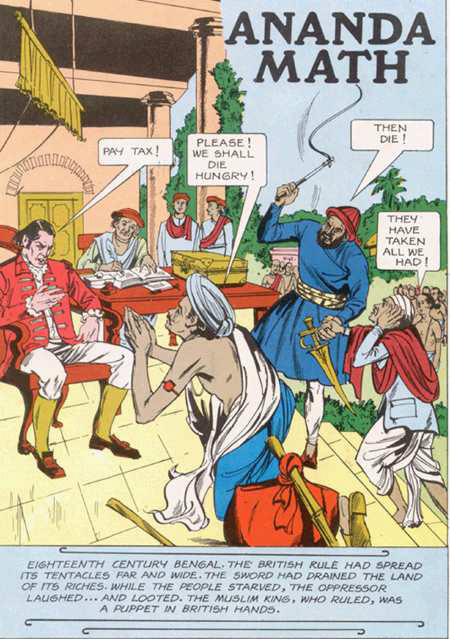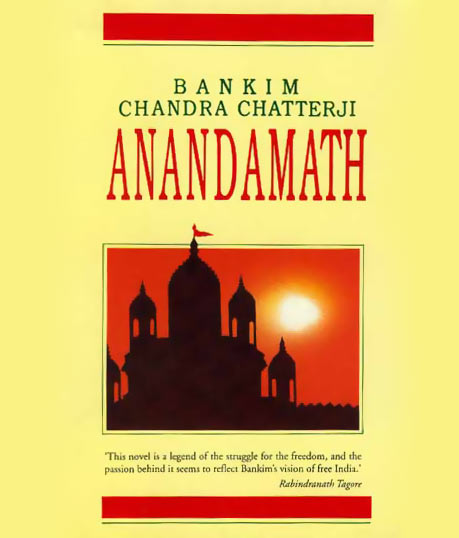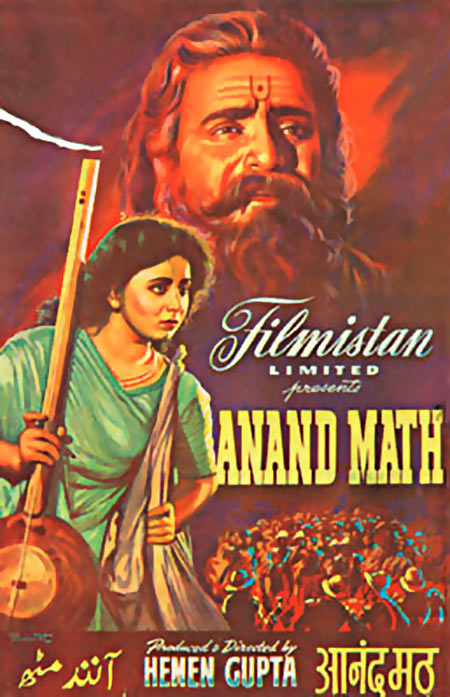 | « Back to article | Print this article |
6 lessons for YOU from India's freedom movement
Has anyone of you heard of the Fakir Sannyasi rebellion yet?
The book Anandamath by Bankim Chandra has remarkable lessons for entrepreneurs on how a group of undervalued people contributed to the freedom movement and took on the British empire.
If you're looking for inspiration, it's got all you need.
I first came across the Fakir Sannyasi rebellion not in the books of history (thank you ridiculous education system) but in a scary tome of literature that I would never have voluntarily opened on my own.
Bankim Chandra Chatterjee's 1882 novel, Anandamath (Abbey of Bliss) is a 336-page long tribute to these heroes of the Indian independence movement that the rest of the country seems to have forgotten.
The novel is otherwise famous for publishing our national song, Vande Mataram and sparking the first kindles of nationalism in a heavily subjugated population.
Vehemently banned by the British government upon its publication, it only came back in print after 1947, long after the author's death.
Bankim Chandra himself was born almost a hundred years after the Fakir Sannyasi rebellion.
Given that there was no internet, or any semblance of documents that would archive dissident's voices, it was a near miracle that he got to hear of this story because that memory had been carefully wiped from the public's memory by the Raj who feared that it might inspire patriotism in the minds of people.
And boy they were right!
For when Bankim's novel went to press and people got to read about how a motley group of untrained and unarmed wayfaring travellers stood up to the might of the British Empire, it struck a hungry flame of imagination that eventually culminated in the glorious struggle for independence.
Chatterjee's grand uncle lived up to the princely age of 108 and it is he who told the little storyteller about the fiercely courageous fighters.
Chatterjee grew up to give his childhood heroes the ultimate tribute in the form of Anandamath, ensuring that their sacrifices be forever honoured and cherished by the people they fought for. Yet how easily we have forgotten them again.
It is astonishing how many entrepreneurship and start-up lessons can be accrued from the story of these eighteenth century brigands.
It is true that inspiration is everywhere, even in the forgotten annals of history.
This just goes to show that starting up is not a course of action. It is a way of life.
Fakirs and sannyasis would travel to North Bengal to visit shrines and sites of pilgrimage there.
This was a tradition predating hundreds of years, if not more.
During their travels, it was customary for them to collect a sizeable amount of alms from the local landlords.
Usually, the zamindars had no problem paying, and collecting this money was an amicable transaction.
But after the consecutive battles of Plassey and Buxar, when Bengal effectively began to be ruled by the British and the Nawab remained merely a figurehead, things changed drastically.
The British increased the diwani (a type of revenue tax) amount by double in the first year they came to power and by ten per cent more the year after that.
A number of their policy moves had a negative effect on the economy, one of which was the famine of 1770.
The landlords could no longer afford to pay the travelling holy men.
Moreover, the British looked upon these sannyasis and fakirs as nothing but robbers and dacoits who were out to get a share of their rightful taxes.
Also they had a problem with so many men moving about in a band.
It made them look suspicious to the foreign government.
They actively tried to bar their entry into Bengal and severely restricted their movements within the state. This effectively put a ban on the kind of lifestyle the sannyasis had been practicing since ancient times.
Then in 1771, nearly a hundred and fifty fakirs were killed for no good reason.
This was a trigger for the rebellion to kick start.
In resistance to orthodox company policies, a version of the rebellion had dawned in the 1760s. But after the events of the early 1770s, it gathered considerable momentum.
Their numbers swelled to more than fifty thousand in the mid 1770s and they could match the soldier headcount of the government army in open warfare.
The fakirs and sannyasis came together to defeat their common enemy -- the British.
The fakirs were mostly from the Madarika sect.
This section had flourished in Bengal under the leadership of Shah Sultan Hasan Suriya Burhana in the latter part of the seventeenth century.
The sannyasis were mostly Vedic yogis belonging to the Giri and Puri groups of ek dandi sannyasism.

Please click NEXT to continue reading...
6 lessons for YOU from India's freedom movement
Strong leadership
A bad leader orders others to follow.
A good leader inspires dedicated followers without ever resorting to authority.
While the Indian army had any number of fancy generals and lieutenants who were driving hundreds of thousands of Indians to fight their own countrymen, the fakirs and sannyasis placed implicit faith and their lives in the hands of their able leaders.
The movement was spearheaded by Muhammad Abu Talib, popularly known as Majanu Shah.
He was a Sufi saint from Mewat and succeeded Shah Sultan Hasan Suriya Burhana to the leadership of the Madaria Sufi in the mid eighteenth century.
Majanu Shah's lieutenants were his right hand men and equally responsible for the initial roaring success of the rebellion.
These included Musa Shah, Cherag Ali Shah, Paragal Shah, Sobhan Shah, Karim Shah, etc.
Among the Sannyasi section, names like Bhabani Pathak, a Bhojpuri Brahmin, and Devi Chaudhurani are famous for their leadership abilities.
These leaders instilled courage and passion that armoured their followers to face the army, even though they were outnumbered one to a hundred.
They personified excellence, led by example and, as Bankim Chandra would have you believe, thundered mighty speeches that shook the soul:
Yet with all this power now,
Mother wherefore powerless thou?
Holder thou of myriad might,
I salute thee, saviour bright,
Thou who dost all foes afright,
Mother, hail!
Thou sole creed and wisdom art,
Thou our very mind and heart,
And the life breath in our bodies,
Thou as strength in arms of men,
Thou as faith in hearts dost reign.
Please click NEXT to continue reading...
6 lessons for YOU from India's freedom movement
Strategy
Just as start-ups cannot hope to match up with large corporations in terms of capital and visibility there was no way the fakirs and sannyasis could match the British army in terms of weapons or numbers. So they played to their strengths.
The rebels mainly engaged in guerilla warfare.
They knew the countryside better than the back of their hands and had been nomadically travelling their whole lives.
They were extremely mobile and could disappear at a moment's notice. They could also camouflage expertly.
This light footedness was their main secret of survival against the military giant that was the British army.
The latter had no idea when or where to expect the attacks from.
Governor General Warren Hastings kept sending his best men to contain the rebellion -- lieutenant Brennan, Captain Grant, Captain De Mackenzie, etc. But the rebels kept thriving.
They did suffer a major defeat at the hands of Major Feltham in 1771, but managed to recover admirably.
As long as the fakirs and sannyasis conducted their battles covertly, they had a clear upper hand.
Focus on your own strengths rather than aspiring for the impossible. If they could do it then, you can do it now!
Community engagement
Where would the rebels be without the support of the peasants and farmers that the British ruthlessly brutalised?
They acted as their intelligence agents and kept them apprised of the company's movements and whereabouts, creating a chain of communication not dissimilar to the telegraph system or the modern social media.
The rebels' target areas were company kuthi's (merchants) and zamindars loyal to the British rule and the houses of their officials.
Consumers realise that they are being exploited by profit driven international corporations just as much entrepreneurs do.
We are on the same boat.
Effective application of eighteenth century community engagement principles in the twenty first century will work wonders for you yet.
Maximise resources
The rebels lived in the jungles, foraged for food and dressed in simple handspun weaves.
The majority of their looted wealth was reserved for arming themselves to the teeth, training camps for new recruits and providing food and water to the famine ravaged country folk in order to maintain their loyalty to the movement.
Identify your organisation's priorities and invest in them wisely. As for the rest, scrounge.
Please click NEXT to continue reading...
6 lessons for YOU from India's freedom movement
Focus
Traditionally, sannyasis and fakirs give up all attachment to the material world and wander the corners of the earth for spiritual salvation.
The ones in Bankim Chandra's story, and consequently history, were brave warrior men and women who gave up their families and livelihoods for one singular cause: the motherland.
They lived in the forest in the 'Abbey of bliss' where bliss was defined by one's active contribution to the movement.
They ate strictly to nourish their bodies, practiced warfare all day long and meditated. They also abstained from, err…, all conjugal activities (if you get my drift).
Naturally you do not have to go to these lengths. You could not if you wanted to anyway.
Where would you find jungles in urban populated cities, how would you live without the internet and above all the how would you practice celibacy?
But your success would be directly proportional to the intensity of your discipline and focus.
Passion: A source for all action
While kingdoms all over the country were crumbling and monarchs were handing over their crowns for fear of persecution, it was these jungle inhabitants who tried to keep enemy forces at bay for as long as they possibly could.
For that reason history salutes them and Bankim Chandra salutes them. And today, so do we.



